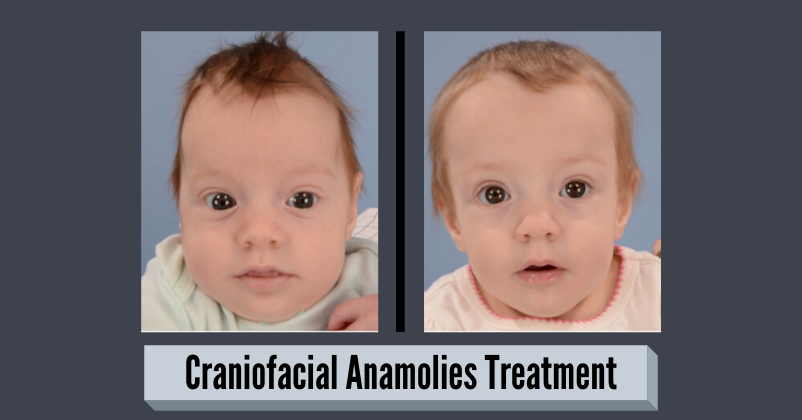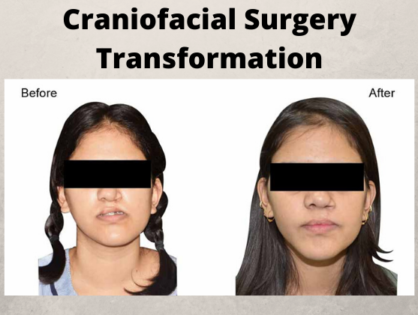Before going for craniofacial surgery, it is is essential to know about the type of syndrome that resulted in deformity or anomaly. In this article, we will learn about the various carniofacial anomalies symptoms, its diagnosis and treatment options. So, let's quickly start.
The skulls of babies include plates of bone, which are separated through soft areas called sutures. During the initial 6 months to 1.5 years of age, the sutures fuses and the skull develops into one piece.
Craniofacial anomalies, involving craniosynostosis, is because of an infant’s skull or facial bones combining together very early or abnormally.
When the bones combine very early, the brain can malfunction as it develops and cannot expand correctly, and the infant may experience neurological issues.
Surgery is essential to correct the contours of the skull and face and provide space for the infant’s growing brain.
Craniofacial Anomalies Symptoms
The craniofacial anomalies can be mild or critical depending on what parts of the baby’s skull have got affected. Particular types of symptoms are called as syndromes and there are many that lead to telltale facial deformities:
- Apert Syndrome: It is a genetic deformity identified by irregularities in head shape and size and joined fingers and toes.
- Craniosynostosis: It is a disorder in which the bones in a baby’s skull join together very early, resulting in a condition where the brain grows in ways that involves abnormal head shape or facial characteristics. Mostly, the non-syndromic craniosynostosis occurs, that means they are not coupled with other abnormalities in the body. Syndromic craniosynostosis happens less often and is coupled with different birth deformities.
- Crouzon Syndrome: It shows anomalies in the face, skull and heart. It is a hereditary syndrome which is because of a mutation on the FGFR2 or FGFR3 gene.
- Deformational plagiocephaly: It involves irregular head shape where bones in the skull are uncommonly shaped by outside forces.
- Facial Paralysis: It is the inability in moving a part or the complete face. It can be for either sides or both the sides of the face. This can cause asymmetry and can result in both social interaction and functional issues.
- Facial Trauma: It shows any irregularity caused to the face that could permanently modify the shape of facial characteristics and working of the mouth, ears, nose or eyes.
- Hemifacial Microsomia: It is a birth deformity that leads to abnormalities of the soft tissue or mouth’s bone, lower and/ or upper jaws and ears that can sustain into childhood.
- Hypertelorbitism: It is termed as orbital hypertelorism which is an uncommonly increased distance between the orbits that is the bony sockets surrounding the eyes.
- Jaw Abnormalities: It is the deformities in the way the jaw grows or works, can happen due to disease or trauma.
Diagnosis of Craniofacial Anomalies
Some of these deformities are by birth, and others happen till a child’s head develops for the starting few months. Mostly, your maxillofacial surgeon can detect a craniofacial deformity through test only. Analyzing the baby’s skull, brain and facial structure through a CT scan or MRI can provide a confirmation for the diagnosis.
Treatment for Craniofacial Anomalies
1. Craniofacial Surgery
Regarding craniosynostosis and other anomalies, you maxillofacial surgeon can suggest craniofacial surgery for treating the physical structure of the skull and facial bones and improve your child's functionality.
These types of surgeries are perplexed and intensive, that requires eliminating, reshaping and replacing some parts of the skull. Pediatric neurosurgeons may coordinate with craniofacial maxillofacial surgeons like Dr. Anurag Bhargava to give the best treatment.
Skull reconstruction may sometimes require the surgeons to use wires, small screws, sutures or plates to balance the bone and defend the brain as your baby grows.
2. Minimally Invasive Surgery
In particular cases, if your baby’s abnormality is detected before he turns three months old, the surgeon may be in a position to utilize one of the many minimally invasive procedures. These endoscopic methods can reduce the chances of blood transfusions and other complications when compared with surgeries and can also result in the speedy recovery of your child.
For any of the conditions, quick decision for treatment by maxillofacial surgeon is essential as the babies’ brain develop faster and it helps as all the treatment options are available at an early age.



I got what you intend,saved to fav, very decent web site. Tanya Jasper Holmann
I gotta favorite this website it seems extremely helpful handy Analiese Crichton Malka
Merely wanna input on few general things, The website layout is perfect, the articles is very great : D. Sonia Brucie Grover
Thanks again for the blog post. Really looking forward to read more. Really Cool. Doralin Otto Ronal